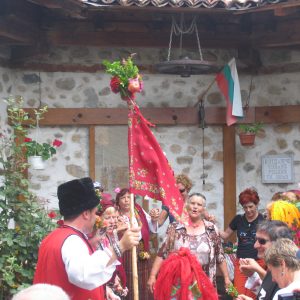Bulgarian Music Folklore
 The spirit of every people is reflected in its folklore – the dialects, the national clothing, the songs, the dances and the music… Bulgarian folklore music culture is lively, rich and original. For centuries on end the people have created songs for labor and beauty, for slavery and fight for freedom, for the fight against evil. That is how labor, horo and sedianka (women’s gathering), table, heroic, ritual, historic songs emerged with their different themes and different place in the life of people. Bulgarian folklore music is original with the peculiarities of its melodies as well as with its rhythm – from the double and triple beats to the irregular beats and the non-measured songs which singers perform only according to their feeling.
The spirit of every people is reflected in its folklore – the dialects, the national clothing, the songs, the dances and the music… Bulgarian folklore music culture is lively, rich and original. For centuries on end the people have created songs for labor and beauty, for slavery and fight for freedom, for the fight against evil. That is how labor, horo and sedianka (women’s gathering), table, heroic, ritual, historic songs emerged with their different themes and different place in the life of people. Bulgarian folklore music is original with the peculiarities of its melodies as well as with its rhythm – from the double and triple beats to the irregular beats and the non-measured songs which singers perform only according to their feeling.
 Women mainly perform the songs while playing of instruments is men’s privilege. The character of its music folklore divides Bulgaria into several folklore regions, different from each other by the character of their songs, instruments and instrumental melodies, folk dances and clothing, etc. Usually the folklore regions coincide with the language dialect regions. Specialists are more and more convinced that the folklore regions actually mark the borders of an old tribal culture different from the one of the neighbouring regions. Often folklore songs, instrumentals and dances of a region are significantly different from the neighboring ones – for example, the three-part Pirin region and the neighboring one-part Rhodope region. Usually the borders between the different regions are sharp, clearly outlined and the “merging” of styles is rare.
Women mainly perform the songs while playing of instruments is men’s privilege. The character of its music folklore divides Bulgaria into several folklore regions, different from each other by the character of their songs, instruments and instrumental melodies, folk dances and clothing, etc. Usually the folklore regions coincide with the language dialect regions. Specialists are more and more convinced that the folklore regions actually mark the borders of an old tribal culture different from the one of the neighbouring regions. Often folklore songs, instrumentals and dances of a region are significantly different from the neighboring ones – for example, the three-part Pirin region and the neighboring one-part Rhodope region. Usually the borders between the different regions are sharp, clearly outlined and the “merging” of styles is rare.
The characteristic features, defining the specifics of the different folklore regions, are the following:
- Manner of singing and playing – ornamented, one-part, two-part, antiphonal (two groups with overlapping), open, closed, nasal, “shaking”, atzane, etc.
- Characteristic modes: melodic lines, cadenzas and melodic structure, irregular metrics and measures.
- Typical genres.
- Instruments.
The borders of the folklore regions are clearly outlined. There are six of them and in some even more specific and interesting sub-regions are isolated.
Here are two of the most famous world-known Bulgarian instruments:
Gaida (Bagpipe)
 The bagpipe has a bag of kid’s leather, which is the air container, as well as wooden parts. They consist of a mouthpiece – a short wooden pipe through which the bagpipe player puts air into the bag.
The bagpipe has a bag of kid’s leather, which is the air container, as well as wooden parts. They consist of a mouthpiece – a short wooden pipe through which the bagpipe player puts air into the bag.
Two sizes of bagpipes are known, as well as three types according to their leading tones:
- High-pitched bagpipe – “djura”;
- Medium-pitched bagpipe;
- Low-pitched Rhodope bagpipe – “kaba”
In it’s lowest tones the bagpipe has a soft and muffled sound. In the high register it turns harsh, sharp and squeaking. When the bagpipe player plays, he holds the bag under his arm and presses it with his elbow to squeeze the air into the drone.
Bagpipe is used a solo, as an accompanying instrument and as an instrument at feasts in the field.
The most famous bagpipe band is in the Rhodopes – “Sto kaba gaidi”
Kaval (Shepherd’s Pipe)
 The shepherd’s pipe is a cylindrical wooden pipe with openings at both ends. There are two kinds of pipe – one-piece and three-piece. Pipes are most often three-piece. The three pieces stick into one another to form a pipe of 60-85 cm.
The shepherd’s pipe is a cylindrical wooden pipe with openings at both ends. There are two kinds of pipe – one-piece and three-piece. Pipes are most often three-piece. The three pieces stick into one another to form a pipe of 60-85 cm.
Kaval is a shepherd’s instrument and was initially hand made by a single piece of wood. Subsequently, the three-piece kavals were developed. They are more convenient to carry since their three pieces can split.
Consecutive opening of the holes with the fingers makes the sound of the pipe together with the specific angle of the first piece with the mouth of the player. Kaval is considered richest in tone among Bulgarian instruments. It is spread throughout the country.



